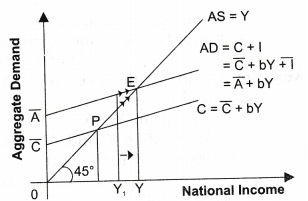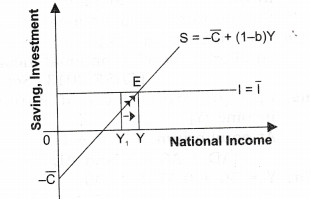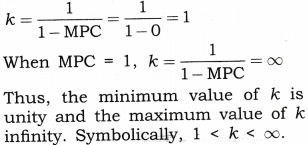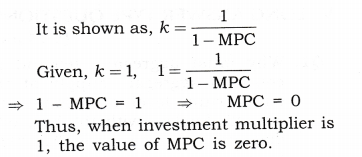Chapter 6 – National Income Determination and Multiplier Questions and Answers: NCERT Solutions for Class 12 Economics
Class 12 Economics (Macro Economics) Chapter 6: National Income Determination and Multiplier - Questions and Answers of NCERT Book Solutions.
Question 1. Measure the level of ex-ante aggregate demand when autonomous investment and consumption expenditure (A) is Rs 50 crores, and MPS is 0.2 and level of income (Y) is Rs 4000 crores. State whether the economy is in equilibrium or not (cite reasons).
Answer: As given in the examination problem, Equilibrium Income (Y) = Rs 4000 crore Autonomous Investment + Autonomous Consumption (A¯) = Rs 50 crore MPS = 0.2
So, MPC(b) = 1 – 0.2 = 0.8
(MPC = 1 – MPS)
AD = C + I
AD = C¯ + bY + I = A¯ + bY
= 50 + 0.8Y (A¯=C¯+I¯)
As we know, the equilibrium level of national income in two-sector model is determined where,
AS = AD
Y = 50 + 0.8Y
4000 = 50 + 0.8(4000)
4000 = 50 + 3200
4000 =3250
Hence, the economy is not in equilibrium.
Question 2. Explain ‘Paradox of Thrift’.
Answer:
1. The term thrift means savings and the paradox of thrift shows how an attempt by the economy as a whole to save more out of its current income will ultimately result in lower savings for the economy.
2. If all the people in the economy make an effort to save more, then the total savings of the community will not increase, on the contrary they will decrease. This is called the paradox of thrift.
3. Reasons for “Paradox of thrift” to operate:
3. (a) As we know that one person’s expenditure is another person’s income.
3. (b) If individual ‘A’ decides to save more by reducing his consumption expenditure, the income of individual ‘B’ will be less and individual ‘B’ in turn will spend less.
3. (c) Thus, if all individuals in the economy decide to save more, the income received by each individual will be less and overall income will fall and also lower will be the total savings.
4. Diagram Representation:

In the above figure , we have induced investment function which makes the investment curve upward positively sloping. With the increase in savings, not only the equilibrium income falls, but also savings decline
Question 3. What is Effective Demand? How will you derive the autonomous expenditure multiplier when price of final goods and the rate of interest are given?
Answer:
1. The level at which the economy is in equilibrium, i.e., where aggregate demand = aggregate supply, is called effective demand.
2. Under fixed price model, the value of planned (ex-ante) aggregate demand for final goods AD is equal to ex-ante consumption plus ex-ante investment expenditure.
AD = C + I = C¯ + bY + I¯
=A¯ + bY
=A¯ = 2 of all autonomous variable, i.e., (A¯=C¯+I¯))
3. As we know that the equilibrium level of national income in two sector model is determined where,
AS = AD
Y=A¯+bY=A¯1−b
4. Diagrammatical representation,

In the above mentioned diagram, aggregate demand is measured on vertical axis and national income is measured on horizontal axis. Initially, at autonomous expenditure A¯, the equilibrium level of national income OY is determined at point E. But due to increase in autonomous expenditure from A¯ to A¯1, the aggregate demand curve shifts upward from AD to AD1 and at the same level of national income, i.e., OY, aggregate demand is greater than aggregate supply. Production will have to be increase to meet the excess demand. Consequently, national income will increase from OY to O
Y1 As, we know positive relationship exists between national income and consumption, so consumption will increase which will, increase the new aggregate demand A D1 , till we reach the new equilibrium level of output i.e., OY1 at E2
I.Very Short Answer Type Questions
Question 1. If planned savings are greater than planned investments, what will be its effect on inventories?
Answer: The inventories will rise.
Question 2. What is meant by effective demand?
Answer: The level at which the economy is in equilibrium, i.e., where aggregate demand = aggregate supply, is called effective demand.
Question 3. Define the term ‘multiplier’. How do we measure it?
Answer: The ratio of change in national income (ΔY) due to change in investment (ΔI) is known as multiplier (K).(K)=ΔYΔI
Question 4. An increase of Rs 1000 crore in invest¬ment leads to a rise of Rs 5000 crore in the national income. Calculate the value of multiplier.
Answer: Multiplier (k)=ChangeinIncomeChangeinInvestment
=50001000 =Rs 5
Question 5. If investment multiplier is 1, what will be the value of marginal propensity to consume?
Answer: Marginal propensity to consume = 0.
Question 6. If marginal propensity to save is 0.1, calculate the value of multiplier.
Answer: Multiplier (k) =11−MPS=10.1=10
Question 7. If the value of marginal propensity to consume is 0.6, calculate the value of multiplier.
Answer: Multiplier K
=11−MPC=10.6=2.5
II. Short Answer Type Questions
Question 1. What happens to the level of national income when aggregate demand falls short of aggregate supply?
Answer:
1. As we know that equilibrium level of national income is determined under the given condition of aggregate demand and aggregate supply, and has tendency to stick to that level i.e., where aggregate demand is equal to aggregate supply.
2. As is given in the examination problem that when aggregate demand falls short of aggregate supply, then national income will decrease as shown in the above mentioned diagram.

3. When AD < AS [At Y1], then there would be stockpiling and producers will produce less. National income will fall and as we know positive relationship exists between national income and consumption, so consumption will fall, which will thereby decrease the aggregate demand till we reach the equilibrium.
Question 2. What happens to the level of national income when aggregate supply falls short of aggregate demand?
Answer:
1. As we know that equilibrium level of national income is determined under the given condition of aggregate demand and aggregate supply, and has tendency to stick to that level i.e., where aggregate demand is equal to aggregate supply.
2. As is given in the examination problem that when aggregate supply falls short of aggregate demand, then national income will increase as shown in the given diagram:

3. When AD > AS [At Y1], then production will have to be increased to meet the excess demand. Consequently, national income will increase. As we know that positive relationship exists between national income and consumption. So consumption will increase, which will thereby increase the aggregate demand till we reach the equilibrium.
Question 3. In an economy planned saving is greater than planned investment. Explain how the economy achieves equilibrium level of national income.
Answer:
1. It refers to the point that has come to be established under the given condition of aggregate demand and aggregate supply, and has tendency to stick to that level under this given condition. Therefore, AD = AS C + I = C + S I = C + S- C = S
2. As given in the examination problem, when planned saving is greater than planned investment, then national income will decrease as shown in the diagram.

3. When saving > investment [at Y1], then there would be stockpiling and producers will produce less. National income will fall and as we know positive relationship exists between national income and saving, then saving will start falling until it becomes equal to investment. It is here the equilibrium level of income is derived.
Question 4. If planned saving is less than planned investment, what changes will bring economy in equilibrium?
Answer:
1. It refers to the point that has come to be established under the given condition of aggregate demand and aggregate supply, and has tendency to stick to that level under this given condition. Therefore,
AD = AS C + I = C + S I=C+S-C=S
2. As given in the examination problem, when planned saving is less than planned investment, then national income will decrease as shown in the below diagram.

3. When, investment > saving [at Y1], then production will have to be increased to meet the excess demand. Consequently, national income will increase leading to rise in saving until saving becomes equal to investment. It is here that equilibrium level of income is established because what the savers intend to save becomes equal to what the investors intend to invest.
Question 5. Discuss relationship between MPC and multiplier.
Answer:
1. If we put maximum value of MPC, i.e., 1, we get maximum value of multiplier, i.e., ∞.
2. As against it, if we put minimum value of MPC, i.e., 0, we get the minimum value of multiplier, i.e. 1.
3. So, positive relationship exists between MPC and multiplier. It means when MPC increases, the multiplier also increases and vice-versa.MPC↑→K↑
Question 6. Discuss relationship between MPS and multiplier.
Answer:
1. If we put minimum of MPS i.e. 0, we get maximum value of multiplier, i.e., ∞.
2. As against it if we get maximum value of MPS, i.e., 1, if we get minimum value of multiplier, i.e.,1.
3. Hence, inverse relationship exists between MPS and multiplier.It means if MPS increases, the multiplier decreases and vice-versa.MPS↑→K↓
Question 7. c = 50 + 0.5Y is the consumption function; where C is consumption expenditure and Y is national income and investment expenditure is 72000 in an economy. Calculate:
(i) Equilibrium level of national income.
(ii) Consumption expenditure at equilibrium level of national income.
Answer:
1. Equilibrium level of national income (Y)
At equilibrium, Y = C + I
[AD = AS = Y and AD = C + I]
Or, Y = 50 + 0.5Y + 2,000
[C = 50 + 0.5Y]
0.5Y = 2,050
Y = Rs 4,100
2. Consumption expenditure at equilibrium level of national income.Putting value of national income of 4,100 in
consumption function, we get: C = 50 + 0.5 x 4,100 C = Rs 2,100
(a) Equilibrium level of national income = 74,100.
(b) Consumption expenditure at equilibrium level of national income = Rs 1740
Question 8. In an economy, C = 200 + 0.75 Y is the consumption function, where C is consumption expenditure and Y is national income and investment expenditure is Rs 4000 in an economy.Calculate Equilibrium level of national income and consumption expenditure.
Answer:
1. Equilibrium level of national income (Y)
At equilibrium, Y = C + I
[AD = AS = Y and AD = C + I] Or, Y = 200 + 0.75 Y + 4,000
[C = 200 + 0.75 Y]
0.25 Y = 1,200
Y = Rs 16,800
2. Consumption expenditure at equilibrium level of national income.Putting value of national income of 16,800 in
consumption function, we get; C = 200 + 0.75 x 16,800
C = Rs 12,800
(a) Equilibrium level of national income = Rs 16,800;
(b) Consumption expenditure at equilibrium level of national income = Rs 12,800
Question 9. From the following data about an economy, calculate (a) equilibrium level of national income and (b) total consumption expenditure at equilibrium level of national income.
(i) C = 200 + 0.5 Y is the consumption function, where C is consumption expenditure and Y is national income.
(ii) Investment expenditure is 1500.
Answer:
1. Equilibrium level of national income (Y)
At equilibrium, Y = C + I
[AD = AS = Y and AD = C + I]M
Or, Y = 200 + 0.5 Y + 1500
[C = 200 + 0.5 Y]
0.5 Y = 1,700
Y = Rs 3400
2. Consumption expenditure at equilibrium level of national income. Putting value of national income of 3400 in consumption function, we get; C = 200 + 0.5 x 3400 C = Rs 1900
(a) Equilibrium level of national income = Rs 3400.
(b) Consumption expenditure at equilibrium level of national income = Rs 1900
Question 10. Calculate equilibrium national income from the following data:
(i) Consumption expenditure at zero income = Rs 60
(ii) Marginal propensity to consume = 0.9 (iii) Investment = Rs 100
Answer: Equilibrium level of national income (Y) At Equilibrium, Y = C + I
[AD = AS = Y and AD = C + I]
Y =C¯ + b Y + I
Or, Y = 60 + 0.9 Y + 100
[C = 60 + 0.9 Y]
0.1 Y = 160
Y = Rs 1600
Question 11. Given consumption function C = 100 + 0.75 Y (where C = -consumption expenditure and Y = national income) and investment expenditure Rs 1,000, calculate: (i) Equilibrium level of national income; (ii) Consumption expenditure at equilibrium level of national income.
Answer:
1. Equilibrium level of national income (Y)
At equilibrium, Y = C + I
[AD = AS = Y and AD = C + I] Or, Y = 100 + 0.75 Y + 1,000
[C = 100 + 0.75 Y]
0.25 Y = 1,100
Y = Rs 4,400
2. Consumption expenditure at equilibrium level of national income. Putting value of national income of 4,400 in consumption function, we get; C = 100 + 0.75 x 4,400 C = Rs 3,400
(a) Equilibrium level of national income = Rs 4,400;
(b) Consumption expenditure at equilibrium level of national income = Rs 3,400
Question 12. In an economy the consumption function is C = 500 + 0.75 Y, where C is consumption expenditure and Y is income. Calculate the equilibrium level of income and consumption expenditure when investment expenditure is Rs 5,000.
Answer:
Equilibrium level of national income (Y)
At equilibrium, Y = C + I
[AD = AS = Y and AD = C + I] Or, Y = 500 + 0.75 Y + 5,000
[C = 500 + 0.75 Y]
0.25 Y = 5,500
Y = Rs 22,000
2. Consumption expenditure at equilibrium level of national income. Putting value of National Income of 22,000 in consumption function, we get;
C = 500 + 0.75 x 22,000 C = Rs 17,000
Equilibrium level of income = Rs 22,000; Consumption expenditure at equilibrium level of income = Rs 17,000.
Question 13. Suppose that consumption equals C = 100 + 0.75 Y, and investment equals I = Rs 50 and Y = C + I. Find;
(i) The equilibrium level of income
(ii) The level of consumption at equilibrium, and
(iii) The level of saving at equilibrium.
Answer:
1. Y = C + I
Y = 100 + 0.75 Y
+ 50
Y – 0.75 Y = 150
0.25
2. C = 100 + 0.75 600 = Rs 550
3. S = Y – C = 600 – 550 = Rs 50
Question 14. Find national income from the following data: Autonomous consumption = Rs 100 Marginal propensity to consume = 0.80 Investment = Rs 50
Answer: As given in the examination problem, Autonomous consumption or C =150 Autonomous investment or I = Rs 50 MPC or b = 0.80 So, AD = C + I = C + bY + I = 100 + 0.8 Y + 50 = 150 + 0.8 Y
As we know that the equilibrium level of national income in two sector model is determined where,
AS = AD
Y = 150 + 0.8Y
Y – 0.8Y = 150 Y(1—0.8) = 150
Y=15020 =Rs 750
Question 15. An economy is in equilibrium. Find Marginal Propensity to Consume from the following: National Income = 2000 Autonomous Consumption = 400 Investment Expenditure = 200
Answer: Autonomous consumption or C = Rs 400 Equilibrium level of income or Y = Rs 2000 MPC or b = ?
At equilibrium, Y = C + I
[AD = AS = Y and AD = C + I] Y = C + bY + I
2000 = 400 + b(2000) + 200 2000 – 600 = b(2000)
1400 = b(2000)
MPC(b) = 0.7
Question 16. An economy is in equilibrium. Calculate the Investment Expenditure from the following: National Income = 800 Marginal Propensity to Save = 0.3 Autonomous Consumption =100
Answer: Autonomous consumption or C = Rs 100 Equilibrium level of income or Y = Rs 800 MPS = 0.3
MPC or b = 1 – MPS = 0.7 At equilibrium, Y = C + I
[AD = AS = Y and AD = C + I]
Y = 100 + 0.7Y + I
800 = 100 + 0.7(800) + I
800 = 100 + 560 + 1
I = 140
Question 17. As a result of increase in investment by Rs 125 crore national income increases by Rs 500 crore. Calculate marginal propensity to consume.
Answer: Multiplier k =ChangeinIncome(ΔY)ChangeinInvestment(ΔI)=500125=4 We also know that Multiplier (k)
=11−MPCor4=11−MPC
or or 4 — 4 MPC = 1 or MPC = 3/4 = 0.75
Question 18. As a result of increase in investment national income increases by Rs 600 crore. If marginal propensity to consume is 0.75, calculate the increase in investment.
Answer: Multiplier (k)
=11−MPC=11−0.75=10.25=4
We also know that k
=ChangeinIncome(ΔY)ChangeinInvestment(ΔI)
4=600ChangeinInvestment(ΔI)
Hence, change in investment(ΔI)
=Rs 150 crore
Increase in investment = Rs 150 crore
Question 19. If marginal propensity to consume is 0.9, what is the value of multiplier? How much investment is needed if national income increases by Rs 5,000 crore?
Answer: Multiplier (k)
=11−MPC=11−0.9=10.1=10
We also know that k
=ChangeinIncome(ΔY)ChangeinInvestment(ΔI)
10=k=5000ChangeinInvestment(ΔI)
Hence, change in investment (ΔI)
= Rs 500 crores
Multiplier (k) = 10;
Increase in investment = Rs 500 crore
Question 20. An increase of Rs 250 crore in investment in an economy resulted in total increase in income of Rs 1,000 crore. Calculate the following: (a) Marginal propensity to consume (MPC), (b) Change in saving, (c) Change in consumption expenditure, (d) Value of multiplier.
Answer: Multiplier k
=ChangeinIncome(ΔY)ChangeinInvestment(ΔI)
=1000250=4
We know that Multiplier (k)
=11−MPCor4=1MPC−1
4-4MPC=1
MPC=3/4=0.75
MPC=ChangeinConsumption(ΔC)ChangeinIncome(ΔY)
0.75= ChangeinConsumption(ΔC)1000
So, change in consumption expen¬diture (C) = Rs 750 crore Change in Saving = Change in Income – Change in Consumption
Expenditure So, Change in Saving = Rs 1,000 crore – Rs 750 crore = Rs 250 crore
(a) Marginal propensity to consume = 0.75
(b) Change in saving = Rs 250 crore
(c) Change in consumption expenditure = Rs 750 crore
(d) Value of multiplier = 4
lll.True Or False
Question 1. Value of investment multiplier varies between zero and infinity.
Answer: False. The value of investment multiplier varies between unity and infinity. This can be proved as follows, When MPC = 0,

Question 2. When marginal propensity to consume is zero, the value of investment multiplier will also be zero.
Answer: False. When MPC = 0, the value of investment multiplier will be equal to unity.
This is shown as,
Multiplier (k) =
When MPC = 0,k=1/(1-0)=1
Question 3. When marginal propensity to consume is greater than marginal propensity to save, the value of investment multiplier would be greater than 5.
Answer: False. Case I: When MPC > MPS (i.e., MPC = 0.6 and MPS = 0.4), the value of the investment multiplier,
k=1MPS=10.4=2.5
Case II: When MPC > MPS (i.e., MPC = 0.9 and MPS = 0.1), the value of the investment multiplier,
k=1MPS=10.1=10
Thus, this statement is false because it is not true in all cases.
Question 4.When investment multiplier is 1, the value of marginal propensity to consume is zero.
Answer: The statement is true. When the value of k = 1, MPC = 0

Question 5. If the ratio of marginal propensity to consume and marginal propensity to save is 4 : 1, the value of investment multiplier will be 4.
Answer:

Last Updated on: December 05, 2025
